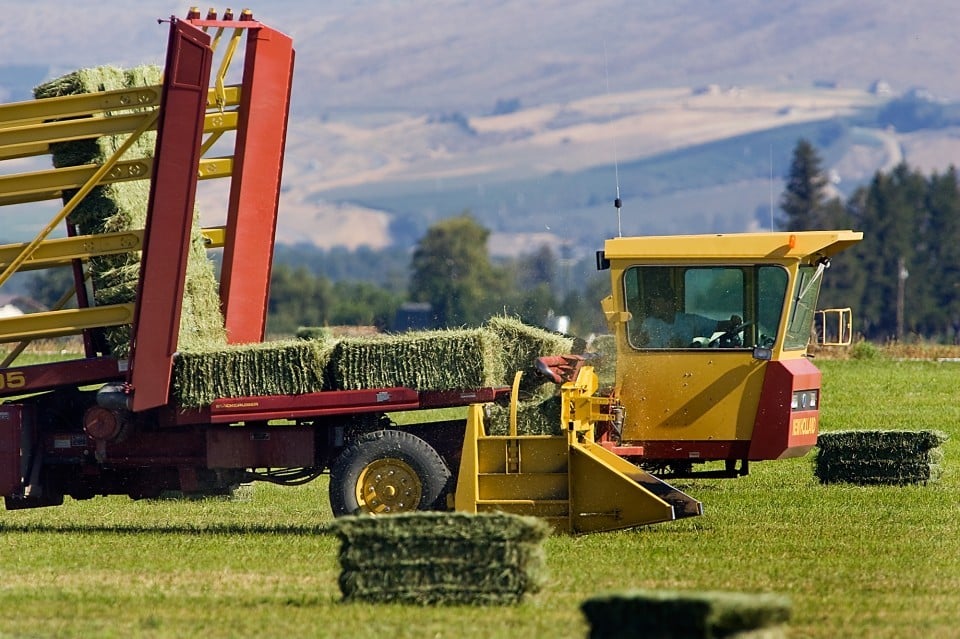How to Bale Hay Like a Pro: Our Secrets for Keeping It Fresh and Clean
Welcome back to our series of blog posts where we reveal how we turn fresh grass into delicious hay. In case you missed our previous posts, we explained how we cut and rake our grass in the first and second steps. Today, we will talk about the third and not quite final step into the process of getting top quality hay to your doorstep.
Baling hay is not just a matter of stuffing some dried grass into a box and calling it a day. Woah, that rhymes. It is a delicate art that requires skill, precision and attention to detail. We must consider many factors, such as size, shape, weight, density and destination. We also must protect our hay from damage and contamination, which can ruin its quality, nutrition and your furry besties satisfaction.
Here are some of the secrets that we use to bale our hay while the sun shines:
Secret #1: We clean the field before planting.
One of the ways to prevent contamination is to make sure that the field is clean and free of rocks, debris and litter. We do this by rolling out the fields and sifting the rocks with special machines before we plant the seeds. This way, we reduce the chances of picking up unwanted materials when we cut, rake and bale the hay.
Secret #2: We use modern equipment that can bale the hay in different forms.
Depending on the customer’s preference, we can bale the hay in different shapes and sizes. We use modern equipment that can adjust the height, pressure and speed of the baling process. We aim to bale our hay when it has reached its peak quality and before it starts to lose its freshness.
We mainly offer two sizes of baled hay:
- Small Bale aka 3-tie-bale aka 3 tie: This is a traditional, single-compressed bale that weighs about 105 lbs and measures approximately 14" x 21" x 44". This bale is ideal for customers who want natural fibers that come from harvesting hay. It is easy to feed and can be unloaded by hand or forklift.
- Big Bale aka Heavy Harry (that’s not a real aka, but it should be): This is a large, double-compressed bale that weighs up to 1,300 lbs and measures about 3’ x 4’ x 48-60". This bale is perfect for customers who want to save on shipping costs and have large-scale feeding needs. It can be incorporated into TMR or feed rations for dairies and ranches. It requires a forklift to move.
There is also another bale format that we should talk about: The Round Bale.
- Round Bale: This is a whimsical, round-shaped bale that weighs about 1,000 lbs and measures about 5’ x 6’. We don’t usually bale in this style, but some customers like it for its aesthetic appeal. It is more common for farms and ranches to feed livestock with this bale. They can roll it out in the field or in a trough and let the animals enjoy an all-you-can-eat buffet.
Secret #3: We compare our balers to Wall-E.
You may be wondering how our balers work. Well, they are similar to what our good friend Wall-E does in the movie. He collects trash and compacts it into neat cubes that he stacks up in piles. Our balers do the same thing, but with dried grass instead of trash. Hey, that also rhymes. They bring the raked and cured hay into the machine, compress it at about 2000 psi, and then deliver neat and tidy bales – 3 tie or Big Bale depending on the Machine.
We love Wall-E because he is cute, hardworking and environmentally friendly. He also has a heart of gold and falls in love with EVE, another robot who scans for life on Earth. We think our balers are cute too, but maybe not as romantic as Wall-E.
Secret #4: We inspect the field before and after baling.
Another way to protect our hay from contamination is to inspect the field before and after baling. We look for any foreign objects that might have found their way into the field, such as litter, plastic, metal or animal carcasses. Why do people litter? Why oh why? Did they learn nothing from Wall-E?
We also check the quality of our hay after baling. We make sure that it is not too wet or too dry, that it has no mold or dust, that it has no weeds or insects, and that it has no damage or discoloration. We want our hay to be fresh, clean and nutritious for our customers.
Secret #5: We stack our hay carefully.
The last secret that we use to bale our hay while the sun shines is to stack our hay carefully. We use different pieces of equipment to load and unload our hay, depending on the type of bale. For the 3-tie bale, we use a harrow bed, which looks like this:

Image source: Ellensburg Daily Record - Bryan Myrick
For the big bale, we use a machine made by Stinger. Quite similar to this.

We stack our hay in a way that maximizes the space and minimizes the exposure to the elements. We avoid stacking our hay too high or too close to each other, as this can cause heat and moisture buildup. We also cover our hay with tarps or sheds to protect it from rain, snow and sun.
We hope you enjoyed learning about how we bale our hay while the sun shines. Next week, we will talk about how we ship our hay to different destinations around the world. Stay tuned for more insights into our hay-making process.
If you have any questions or comments, please feel free to contact us. We would love to hear from you.
And remember don’t be a hay-ter, be a hay-maker!
